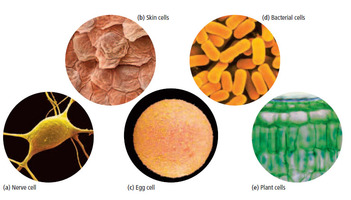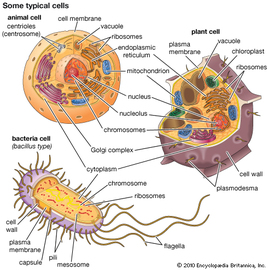Quarter 1
Unit 1: Cell Functions
23 September - 9 October
|
Essential Questions and Ideas
|
Standards Addressed
|
Cell Functions PreTest and Differentiation
23 September
|
Pre-test data will be collected and used by the teacher to offer alternative projects to demonstrate mastery. You may also self select for an alternative assignment upon conferencing with your teacher. Please discuss with your teacher if you have any questions.
|
Cell Functions Preview
All Living Things are Made of Cells
| |||||||||
|
Standard Practiced:
7.21 Big Ideas:
|
Terms to Know:
organism unicellular multicellular microscope bacteria
| ||||||
Practice
1. The Cell Is Basic Reading and Notes
(20-40 min)
Complete the reading and take notes on big ideas, terms to know and diagrams in your binder.
2. Extend what you Know
(10-20 min)
Draw a picture of any animal that exhibits all the Characteristics of Living using your notes and reading.
3. Assessment
(Prep = 5-30 min)
Create a 1 minute speech about the importance of CELL THEORY or the CHARACTERISTICS OF LIFE to share with your class on Monday, 28 September. Eye contact, projection and content should be maintained.
Directions and Think sheet found HERE.
(20-40 min)
Complete the reading and take notes on big ideas, terms to know and diagrams in your binder.
2. Extend what you Know
(10-20 min)
Draw a picture of any animal that exhibits all the Characteristics of Living using your notes and reading.
3. Assessment
(Prep = 5-30 min)
Create a 1 minute speech about the importance of CELL THEORY or the CHARACTERISTICS OF LIFE to share with your class on Monday, 28 September. Eye contact, projection and content should be maintained.
Directions and Think sheet found HERE.
Cells
| |||||||||
|
Standard Practiced:
7.21 7.22 7.23 7.24 |
Practice Pages:
| ||||||
Practice
1. Cells Reading and Notes
(10-20 min)
Complete the Cells Reading by talking to the text. Write 5 interesting facts from the reading in the space provided on your sheet
2. Bill Nye Cells and Cornell Notes
(22-30 min)
Watch the video and take Cornell Notes on the CN sheet provided. Be sure to include any drawings that might help you best understand.
3. Review your notes
(5-15 min)
Check with your table partner and add anything that you feel you should. Then read through them one more time. =)
(10-20 min)
Complete the Cells Reading by talking to the text. Write 5 interesting facts from the reading in the space provided on your sheet
2. Bill Nye Cells and Cornell Notes
(22-30 min)
Watch the video and take Cornell Notes on the CN sheet provided. Be sure to include any drawings that might help you best understand.
3. Review your notes
(5-15 min)
Check with your table partner and add anything that you feel you should. Then read through them one more time. =)
Parts and Function of a Microscope
| |||||||||||||
| parts_and_functions_microscope.pdf | |
| File Size: | 479 kb |
| File Type: | |
| the_enormous_e.pdf | |
| File Size: | 511 kb |
| File Type: | |
Practice
1. Parts and Functions and Magnification
(5-10 min)
Watch the introduction video using your ear buds. Review the "Parts and Functions of a Microscope" practice page and complete.
2. The ENORMOUS e
(55 min)
Review the directions and complete the lab.
(5-10 min)
Watch the introduction video using your ear buds. Review the "Parts and Functions of a Microscope" practice page and complete.
2. The ENORMOUS e
(55 min)
Review the directions and complete the lab.
The Different Jobs of Cells
| |||||||||||||||||||||||||
| different_jobs_of_cells.doc | |
| File Size: | 45 kb |
| File Type: | doc |
| different_jobs_of_cells_reading.pdf | |
| File Size: | 388 kb |
| File Type: | |
| levelsorganization_08.doc | |
| File Size: | 30 kb |
| File Type: | doc |
| levels_of_organization_reading.pdf | |
| File Size: | 490 kb |
| File Type: | |

1. Reading: The Different Jobs of Cells
(5-10 Min)
Talk to the text "The Different Jobs of Cells" provided in class or on the website.
2. Graphic Organizer: The Different Jobs of Cells
(20-30min)
Using the example as a guide to identify different examples of plant and animal cells, their form (size and shape) and their function.
3. Reading: Levels of Organization
(5-10 Min)
Talk to the text "Levels of Organization" provided in class or on the website.
4. Graphic Organizer: Levels of Organization
(20-30min)
Using your reading to define the words, provide and example by drawing a picture and labeling it.
5. Review
(10-15min)
Review this SHORT VIDEO and check your answers with the class, partners or other tables and make them better.
(5-10 Min)
Talk to the text "The Different Jobs of Cells" provided in class or on the website.
2. Graphic Organizer: The Different Jobs of Cells
(20-30min)
Using the example as a guide to identify different examples of plant and animal cells, their form (size and shape) and their function.
- Human Red Blood Cell
- Human Fat Cell
- Human Skin Cell
- Human Muscle Cell
- Human Nerve Cell
- Plant Leaf Cell
- Plant Stem Cell
- Plant Root Cell
- Human Bone Cell
3. Reading: Levels of Organization
(5-10 Min)
Talk to the text "Levels of Organization" provided in class or on the website.
4. Graphic Organizer: Levels of Organization
(20-30min)
Using your reading to define the words, provide and example by drawing a picture and labeling it.
5. Review
(10-15min)
Review this SHORT VIDEO and check your answers with the class, partners or other tables and make them better.
#17 Cell Journal
| |||||||||||||||||||||
|
Standard Practiced:
7.21 7.22 7.24 |
Practice Pages:
| ||||||||||||||||||
Cell Journal Practice

Directions:
Over the next 3 days you will thoughtfully complete your cell journal, review with your partner and class and submit for a grade. This assignment will demonstrate your depth of knowledge and count as a mastery check.
If you miss a day you may complete the alternative assignment described in the practice page labeled ALTERNATIVE ASSIGNMENT. Or you may complete during lunch or before school with a teacher note.
LABS TO COMPLETE USING YOUR CELL JOURNAL:
1. Nerve Cell and Guard Cell Notes
2. Cheek to Cheek
3. The Green Machine
4. Dropping in on Protozoa
Over the next 3 days you will thoughtfully complete your cell journal, review with your partner and class and submit for a grade. This assignment will demonstrate your depth of knowledge and count as a mastery check.
If you miss a day you may complete the alternative assignment described in the practice page labeled ALTERNATIVE ASSIGNMENT. Or you may complete during lunch or before school with a teacher note.
LABS TO COMPLETE USING YOUR CELL JOURNAL:
1. Nerve Cell and Guard Cell Notes
2. Cheek to Cheek
3. The Green Machine
4. Dropping in on Protozoa
#18 Cells to Systems
12-13 October
|
Cell to Systems Notes
15-25 min Use the review and create Cornell Notes to cover the following big ideas: -Cells -Animal cells and plant cells -Cells and their functions -Cells, tissues and organ system Practice 10-15 min Complete this Learning Activity with your ear buds and add anything you learn to your notes Self Assessment 5-10 min 1. Complete the 9 question Self Assessment. Write your score on the top of your notes. Anything you got wrong go back into the notes or practice above to correct or add to your notes. |
#19 Life in a Drop of Water Video
|
Life in a Drop of Water PracticeLife in a Drop of Water and Cornell Notes
(22-30 min) Watch the video and take Cornell Notes OR complete the note sheet below. Be sure to include any drawings that might help you best understand.
| ||||||
#17 Cell Journal Part 2
14-15 October
Cell Function and Structure Quiz Review
|
Cell Function and Structure Quiz
|
Extra Credit

Bring in a sealed and labeled Pond Water Sample by 9 October. We will look at your sample during the last day of our Cell Journal.

